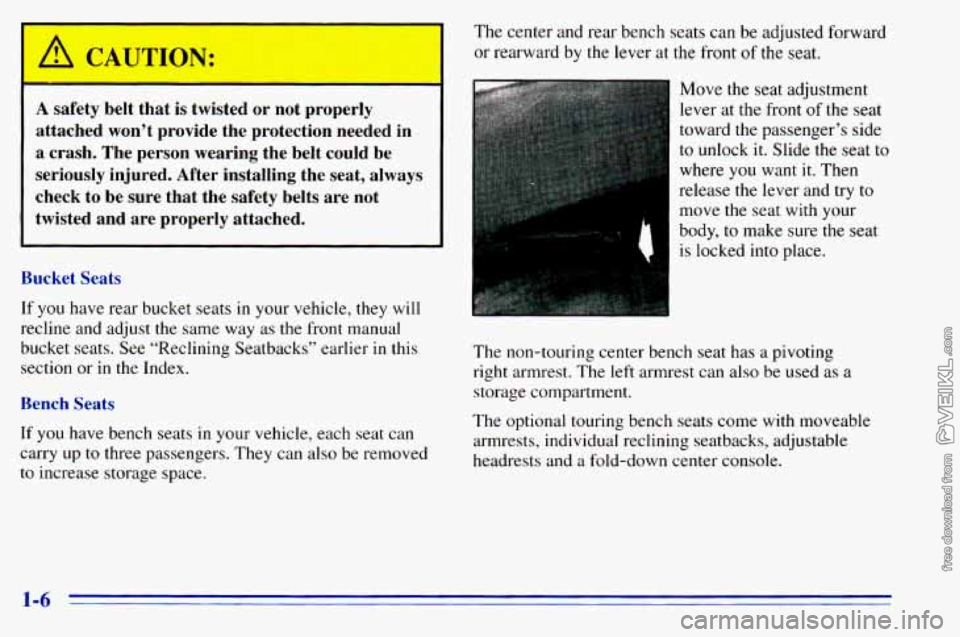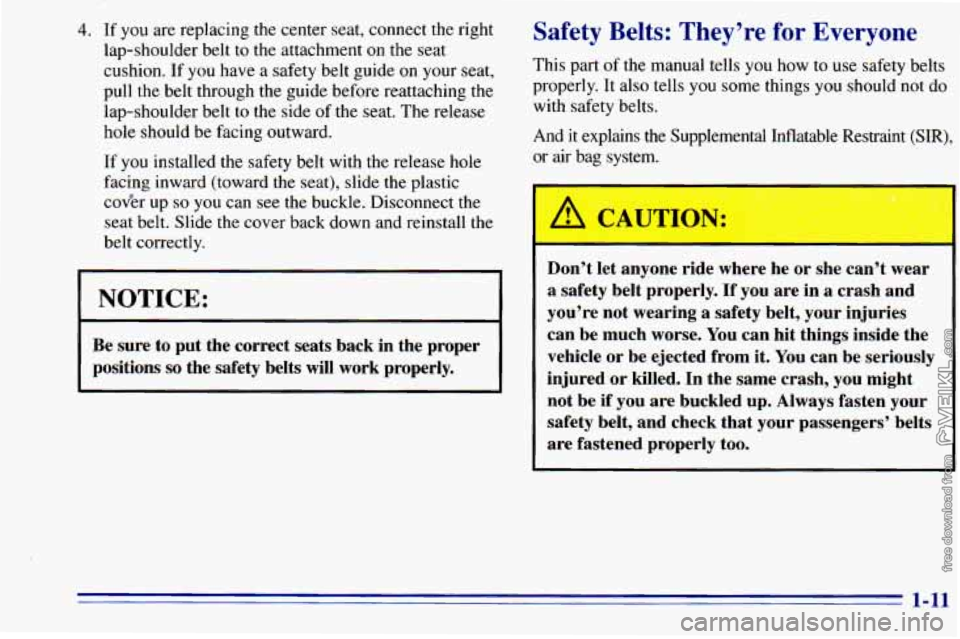Page 3 of 372

The 1996 Chevrolet Astro Owner’s Manual
Beats and Restraint Systems ............................................................. 1-1
This section tells you how to use your seats and safety belts\
properly. It also explains the “SIR” system.
Features and Controls .................................................................. 2-1
This section explains how to start and operate your vehicle.
Bmfort Controls and Audio Systems ..................................................... 3-1
This section tells you how to adjust the ventilation and comfo\
rt controls and how to operate your
audio system.
Here
you’ll find helpful information and tips about the road and how to d\
rive under different conditions.
This section tells you what to do
if you have a problem while driving, such as a flat tire or ove\
rheated
engine, etc.
Here the manual tells you how to keep your vehicle running pr\
operly and looking good.
This section tells you when to perform vehicle maintenance and \
what fluids and lubricants to use.
This section tells you how to contact Chevrolet for assistance \
and how
to get service and owner
publications.
It also gives you infomation on “Reporting Safety Defects” on page 8-8.
Here’s an alphabetical listing of almost every subject in this manual. You can use it to quickly find
something
you want to read.
YourDrivingandtheRoad .............................................................. 4-1
Problems on the Road .................................................................. 5-1
Service and Appearance Care ............................................................ 6-1
Maintenanceschedule. ................................................................. 7-1
Customer Assistance Information ........................................................ 8-1
Index ........................................................................\
........ 9-1
i
Page 7 of 372
Vehicle Symbols
These are some of the symbols you may find on your vehicle.
For example,
these symbols
are used on an
original battery:
POSSIBLE A
CAUTION
INJURY
PROTECT EYES BY
SHIELDING
CAUSTIC
ACID COULD BATTERY
CAUSE
BURNS
SPARK
OR ,111,
COULD FLAME
EXPLODE BATTERY
These symbols are important
for you and
your passengers
whenever your
vehicle
is
driven:
DOOR LOCK
FASTEN SEAT
BELTS
These symbols have
to do with
your lights:
SIGNALS e
TURN
WARNING
A
HAZARD
FLASHER
FOG LAMPS
$0
These symbols are on
some of
your controls:
WIPER w
WINDSHIELD
DEFROSTER
VENTILATING FAN
(
-b
-J
These symbols are used on
warning and
indicator lights:
COOLANT -
TEMP -
CHARGING I-1
BATTERY
SYSTEM
BRAKE
(0)
COOLANT a
ENGINE OIL w,
PRESSURE
ANTI-LOCK
(@)
BRAKES
Here are some
other symbols
you may see:
FUSE
I
LIGHTER n
HORN )a(
SPEAKER
b
FUEL p3
V
Page 9 of 372
Section 1 Seats and Restraint Systems
Here you’ll find information about the seats in your
vehicle and how to use your safety belts properly.
You
can also learn about some things you should not do with
air bags and safety belts.
Seats and Seat Controls
This section tells you about the seats -- how to adjust
them, take them
out and put them back in. It also tells
you about bucket and bench seats, power seats and
head restraints.
Manual Front Seat
A CAUTION:
You can lose control of the vehicle if you try to
adjust a manual driver’s seat while the vehicle
is
moving. The sudden movement could startle and
confuse you,
or make you push a pedal when you
don’t want to. Adjust the driver’s seat only when
the vehicle
is not moving.
1-1
Page 12 of 372
J
But don’t have a seatback reclined if your vehicle is moving. Sitting in
a reclined position when
your vehicle is
in motion can be dangerous. Even if you buckle
up, your safety belts can’t do their job when
you’re reclined like this.
The shoulder belt can’t do its job because it
won’t be against your body. Instead, it
will be in
front of you. In a crash you could go into it,
receiving neck or other injuries.
The lap belt can’t do its job either. In a crash the
belt could go up over your abdomen. The belt
forces would be there, not at your pelvic bones.
This could cause serious internal injuries.
For proper protection when the vehicle is in
motion, have the seatback upright. Then sit well
back in the seat and wear your safety belt properly.
1-4
Page 14 of 372

1 A, CAUTION:
A safety belt that is twisted or not properly
attached won’t provide the protection needed in
a crash. The person wearing the belt could be
seriously injured. After installing the seat, always
check to be sure that the safety belts are not
twisted and are properly attached.
Bucket Seats
If you have rear bucket seats in your vehicle, they will
recline and adjust the same way as the front manual
bucket seats. See “Reclining Seatbacks” earlier in this
section or in the Index.
Bench Seats
If you have bench seats in your vehicle, each seat can
carry up
to three passengers. They can also be removed
to increase storage space. The
center and rear bench seats
can be adjusted forward
or rearward by
the lever at the front of the seat.
Move the seat adjustment
lever at
the front of the seat
toward the passenger’s side
to unlock
it. Slide the seat to
where you want it. Then
release the lever and try to
move the’seat with your
body,
to make sure the seat
is locked into place.
The non-touring center bench seat has a pivoting
right armrest. The left armrest can also be used as
a
storage compartment.
The optional touring bench seats come with moveable
armrests, individual reclining seatbacks, adjustable
headrests and a fold-down center console.
1-6
Page 16 of 372
Removing the Rear Seats
To remove the rear seats, do the following:
7-7 I TO DETACH
1 BELT FOR 1
I SEAT REMOVAL
I
I! + iI
1 ANDIUSH 11
1 . INSERT KEY
INTO HOLE
I I I
1. If you are removing the
center seat, remove the
right lap-shoulder belt.
To do this, press the tip
of a
key into the release
hole
of the safety belt
attachment while pulling
up on the safety belt.
2. If you have a safety belt
guide on your seat, pull
the safety belt all the way
out through
the guide.
3. Pull up on the seatback latch on the right rear of the
front seat. Push the seatback down until it locks in
place (non-touring bench seats only).
1-8
Page 19 of 372

4. If you are replacing the center seat, connect the right
lap-shoulder belt to
the attachment on the seat
cushion. If you have a safety belt guide on your seat,
pull the belt through the guide before reattaching the
lap-shoulder belt to the side of the seat. The release
hole should be facing outward.
If you installed the safety belt with the release hole
facing inward (toward the seat), slide the plastic
cov’er up
so you can see the buckle. Disconnect the
seat belt. Slide the cover back down and reinstall the
belt correctly.
NOTICE:
Be sure to put the correct seats back in the proper
positions
so the safety belts will work properly.
Safety Belts: They’re for Everyone
This part of the manual tells you how to use safety belts
properly. It also tells you some things you should not
do
with safety belts.
And
it explains the Supplemental Inflatable Restraint (SIR),
or air bag system.
Don’t let anyone ride where he or she can’t wear
a safety belt properly. If you are in a crash and
you’re not wearing a safety belt, your injuries
can be much worse. You can hit things inside the
vehicle or be ejected from it. You can be seriously
injured or killed. In the same crash, you might
not be if you are buckled up. Always fasten your
safety belt, and check that your passengers’ belts
are fastened properly
too.
Page 20 of 372
Your vehicle has a light that
comes
on as a reminder to
buckle up. (See “Safety
Belt Reminder Light” in
the Index.)
In most states and Canadian provinces, the law says to
wear safety belts. Here’s why:
They work.
You never know if you’ll be in a crash. If you do have a
crash,
you don’t know if it will be a bad one.
A few crashes are mild, and some crashes can be so
serious that even buckled up a person wouldn’t survive.
But most crashes are in between. In many
of them,
people who buckle up can survive and sometimes walk
away. Without belts they could have
been badly hurt
or killed.
After more than
25 years of safety belts in vehicles,
the facts are clear. In most crashes buckling up does
matter
... a lot!
Why Safety Belts Work
When you ride in or on anything, you go as fast as it goes.
Take the simplest vehicle. Suppose it’s just a seat on whee\
ls.
1-12 -5